To tie two ropes of equal thickness together so that they will appear to be tied with a reef knot, and will be retied with a true reef knot. This knot was often used by sailors to tie their sea chests, hence the name.
CARRICK BEND
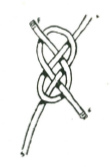
This bend is for the secure fastening of two ropes of even thickness together. It is particularly suitable for hawsers and steel cables. It can be readily undone and does not jam, as do many other bends and knots.
STOPPER HITCH

To fasten a rope to another rope (or to a spar) on which there is already a strain. When the hitch is pulled tight the attached rope will not slip, and the tension on the main rope can be taken on the attached rope. Also useful for a climbing hitch.
FLEMISH KNOT or DOUBLE OVERHAND KNOT

For securing two ropes or cords of equal thickness together.
FISHERMAN’S KNOT

For joining two springy materials together; suitable for wire, fishing gut or vines. Two thumb knots (one on each rope) pulled tight. The knots lock together.

OVERHAND FISHERMAN’S KNOT
Similar to fisherman’s knot; for general uses. More positive for gut fishing lines and nylon.
KNOTS TO MAKE LOOPS IN ROPE
BOWLINE

To form a loop that will not slip on a rope end.
BOWLINE ON A BIGHT

To make a double loop that will not slip on a rope end. Also called a bo’sun’s chair.
FISHERMAN’S EYE KNOT

This is the best method of making a loop or eye in a fishing line. The strain is divided equally between the two knots.
SLIP KNOT

For fastening a line to a pier or a pole or any other purpose where strain alone on the standing end is sufficient to hold the knot.
OVERHAND EYE KNOT

This method of making an eye or loop is satisfactory and quick, but it sometimes jams and becomes difficult to untie.
FLEMISH EYE KNOT

Used for all purposes where a loop is required, less likely to jam than overhand eye knot.
CRABBINS HITCH

This eye knot, though not very well known, is one of the stoutest eye knots. It has not the tendency to cut itself or pull out common to some of the other eye knots. It also makes a useful running knot.
MANHARNESS KNOT
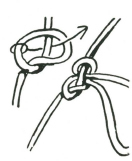
This is a most useful knot for making a series of non-slip loops in a rope for the purpose of harnessing men for a pull. The marlinspike hitch is made as in lower sketch and then the loop is drawn under and over the other two ropes as indicated. The whole knot is then pulled taut.
MIDSHIPMAN’S HITCH

This is an old-fashioned hitch often used to fasten a block or sheave to a rope’s end.
JURY KNOT or TRUE LOVER’S KNOT
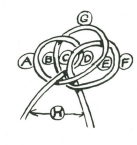

This knot is primarily for a mast head, to form loops by means of which the mast may be stayed. It is called a jury knot because in sailing ship days it was often used to rig a temporary or jury mast. Three hitches as in top sketch are formed. The loop C is pulled under B and over A. D is pulled over E and under F. G is pulled straight up for the third loop. H is made by splicing the two free ends together.
BOW THONG HITCH
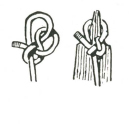
Used by New Guinea natives for securing the end of the split cane bow thong to the pointed end of the bow. Also useful for fastening rope over the tapered end of a spar.
KNOTS FOR FASTENING ROPES
SLIPPERY HITCH
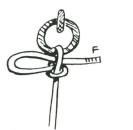
Very useful because of the ease with which it can be released in emergency. It holds securely for so long as there is a strain on the standing end.
CLOVE HITCH
For securing a rope to a spar. This hitch, if pulled taut, will not slip up or down on a smooth surface. A useful start for lashings.

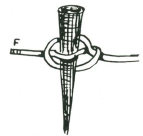
BOAT KNOT
This is a method of securing a rope to a thole pin or other small piece of wood on a boat. It is quickly released.
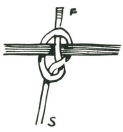
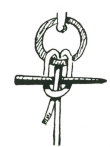
DOUBLE BOAT KNOT
A bight is simply passed through the ring and a marlin spike or other round piece of wood is put between the bight or the rope. Withdrawal of the spike quickly releases the knot.

SLIPPERY HITCH
Very useful because of the ease with which it can be released in emergency. It holds securely so long as there is a strain on the standing end.
ROLLING HITCH
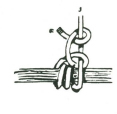
To fasten a rope to a spar. This is a very secure fastening.
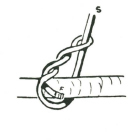
TIMBER HITCH
For securing a rope to squared timber, round logs, etc. A good starting knot for all lashings. The standing end must pull straight through the loop, not backwards, or the rope may cut upon itself.

HALLIARD HITCH
For fastening a rope to a spar. The sketch shows the hitch open. When pulled taut, and the hitches closed, it makes a very neat and secure fastening.

BLACKWALL HITCH
A quick way to secure a rope to a hook. The strain on the standing end will hold the rope secure to the hook.
NOOSE HITCH
This is a quick and easy method of securing a rope to a spar or beam. If desired, the rope can be made more secure by means of the overhand knot shown in Fig. 2.
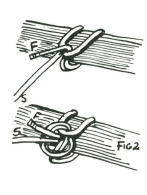
CAT’S PAW HITCH
For securing a rope to a hook or a spar. It is most useful because it is so easily tied.


LARK’S HEAD
This is an easy method of securing a rope to a ring or hook. If desired to make more secure, it can be stoppered, as shown, with an overhand or thumb knot.